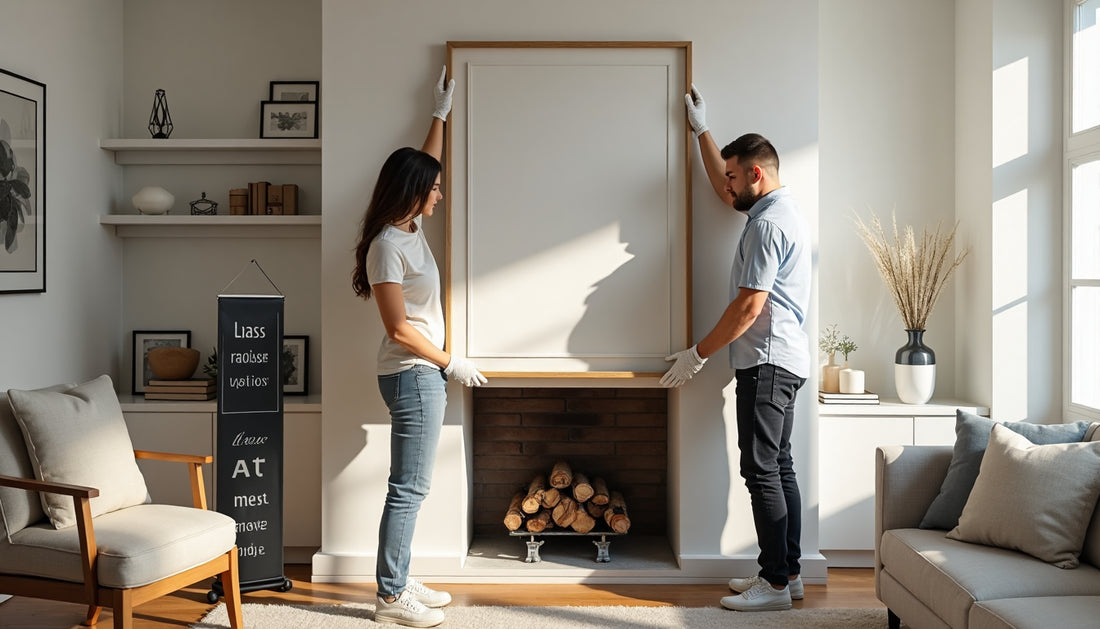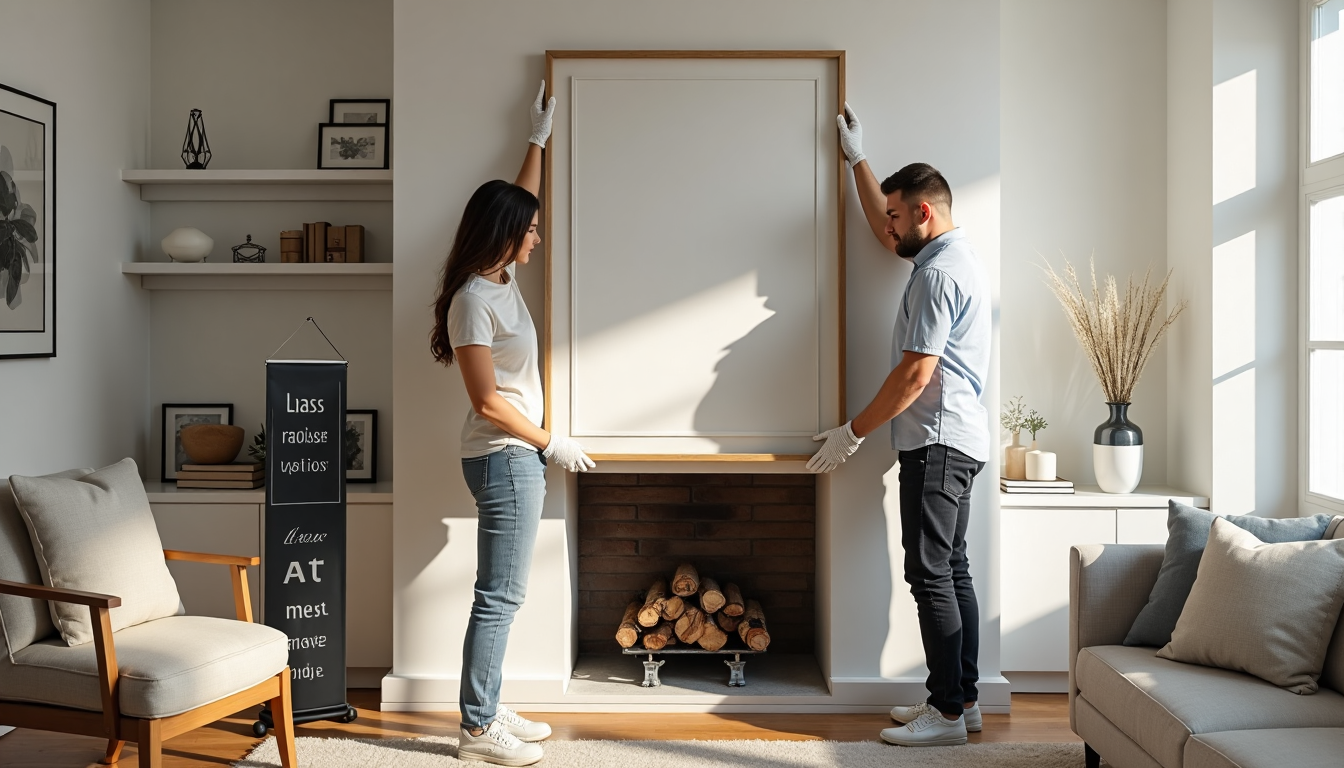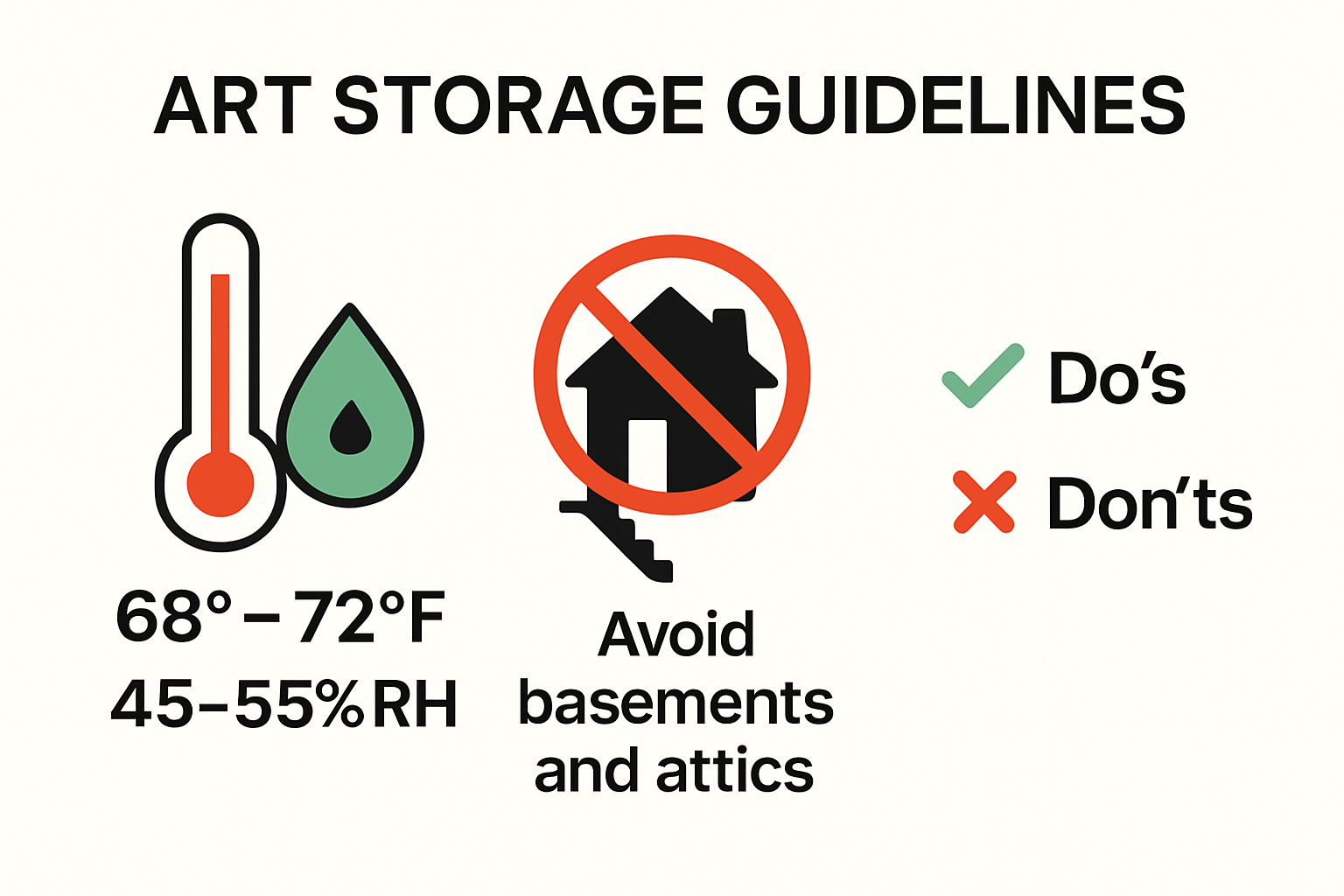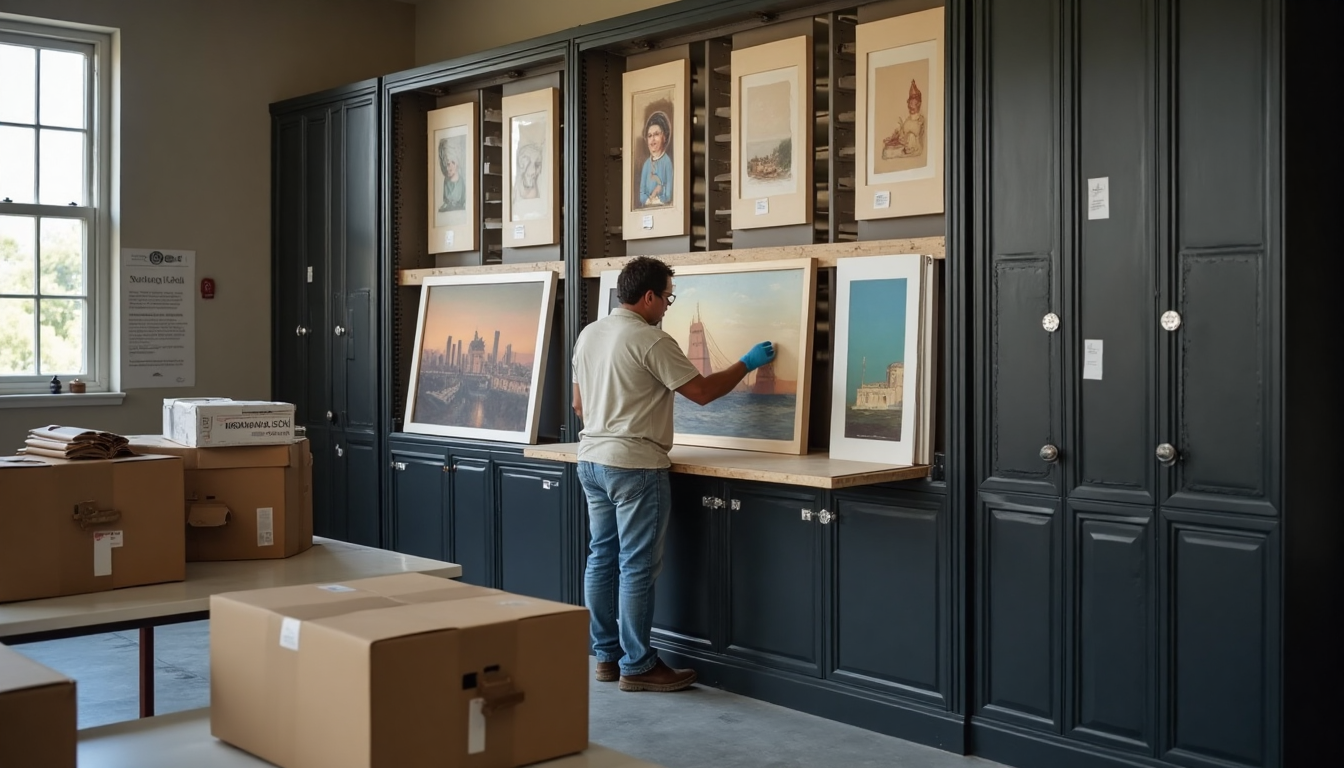
How to Store Art Safely: Protect Your Wall Art and Canvas in 2025

Storing your art might seem as simple as sliding a painting under the bed or stacking canvases in the attic. Shocking fact: improper storage can destroy a painting in just a few months due to humidity and temperature swings, wiping out both beauty and value. Here is the real surprise—most damage happens quietly in spaces people think are safe. It turns out that the secret to preserving your artwork is not where you store it, but how meticulously you control its environment and materials.
Table of Contents
- Choosing The Right Environment For Safe Art Storage
- Best Materials And Supplies For Art Protection
- Step-By-Step Guide To Storing Wall Art And Canvas
- Common Mistakes To Avoid When Storing Art
Quick Summary
| Takeaway | Explanation |
|---|---|
| Temperature and Humidity Control | Maintain a stable environment with relative humidity between 40–60% and temperature between 16–25°C to prevent deterioration of artwork. |
| Light and Pest Management | Utilize UV light filters and conduct regular inspections to protect art from light damage and pest infestations, respectively. |
| Proper Handling Techniques | Always handle artwork with clean white cotton gloves and support pieces properly to minimize the risk of damage during movement. |
| Use Archival Materials | Invest in acid-free, archival-grade supplies for mounting and storing art to prevent chemical damage and ensure longevity. |
| Detailed Documentation | Create a comprehensive inventory, including photographs and condition reports, to document the state of each piece before storage for future reference. |
Choosing the Right Environment for Safe Art Storage
Storing art requires more than simply finding an empty space. Your art collection demands a carefully curated environment that protects its integrity and preserves its beauty for years to come. Understanding the nuanced requirements of art storage can mean the difference between maintaining a pristine collection and watching your valuable pieces deteriorate.
Temperature and Humidity Control
Temperature and humidity are the most critical factors in art preservation. According to International Institute of Conservation, maintaining a stable environment with relative humidity between 40–60% and temperature between 16–25°C is crucial to prevent artwork deterioration. Extreme fluctuations can cause significant damage, including:
- Warping: Sudden temperature changes can cause canvas materials to expand and contract
- Mold Growth: High humidity creates an ideal breeding ground for destructive microorganisms
- Paint Cracking: Inconsistent environmental conditions stress artwork materials
Invest in a high-quality hygrometer and digital thermometer to monitor your storage environment continuously. Climate-controlled rooms or specialized art storage cabinets can provide the consistent conditions your artwork requires.

Light and Pest Management
Protecting Art from Light Damage
Smithsonian Archives recommends utilizing ultraviolet (UV) light filters on lighting fixtures to minimize light-induced degradation. Direct sunlight and harsh artificial lighting can cause irreversible color fading and material breakdown. Strategies to protect your art include:
- Positioning artwork away from direct sunlight
- Using UV-filtering glass or acrylic for framing
- Installing museum-grade LED lighting with low UV emissions
Integrated Pest Management
Pests represent another significant threat to art collections. Smithsonian Institution Archives suggests implementing integrated pest management (IPM) strategies. Regular inspections and preventative measures can protect your artwork from insect and rodent damage. Key strategies include:
- Conducting periodic visual inspections
- Sealing potential entry points
- Using pheromone traps in storage areas
- Maintaining clean, dust-free environments
Storage Location Considerations
Choosing the right storage location goes beyond environmental controls. Consider these additional factors:
- Avoid basements with potential moisture issues
- Select interior rooms with minimal external wall exposure
- Ensure adequate air circulation
- Keep artwork elevated from floor surfaces
- Use acid-free archival materials for wrapping and storage
By meticulously managing your art storage environment, you transform a simple storage space into a protective sanctuary for your cherished pieces. Your proactive approach ensures that each artwork remains as vibrant and captivating as the day you acquired it.
To help you compare some of the environmental threats and solutions for safe art storage, here is a summary table for easy reference:
| Threat | Potential Damage | Preventive Solution |
|---|---|---|
| Temperature Fluctuations | Warping, paint cracking, canvas expansion/contraction | Maintain 16–25°C; use climate control |
| High Humidity | Mold growth, material degradation | Keep RH at 40–60%; use dehumidifiers |
| Direct Sunlight/UV | Color fading, material breakdown | Use UV filters, museum-grade LED lighting, shade art |
| Pests (insects/rodents) | Physical/structural damage, staining, material loss | Seal entry points, conduct inspections, IPM, traps |
| Dust and Dirt | Surface soiling, abrasion | Clean environments; proper framing/backing; dust covers |
Best Materials and Supplies for Art Protection
Protecting your art collection requires more than good intentions. The right materials and supplies can create a critical shield against potential damage, preserving the beauty and value of your artwork for generations. From specialized storage solutions to protective packaging, selecting the appropriate materials is an art form in itself.
Framing and Mounting Materials
Protective Glazing and Backing
The foundation of art protection begins with proper framing techniques. According to the Canadian Conservation Institute, using appropriate glazing materials is crucial for artwork preservation. Glass and acrylic sheets provide multiple layers of protection:
- Physical Protection: Shields artwork from dust, dirt, and accidental impacts
- Environmental Barrier: Reduces exposure to humidity and temperature fluctuations
- UV Protection: Specialized glazing can block harmful ultraviolet radiation
Canadian Conservation Institute recommends attaching a rigid backing board, such as fluted plastic sheets, to the reverse of canvas paintings. This technique offers multiple benefits:
- Prevents mechanical damage
- Reduces dust accumulation
- Buffers humidity fluctuations
- Provides structural support
Archival Storage Materials
Acid-Free and Conservation-Grade Supplies
Western Australian Museum emphasizes the critical importance of using acid-free materials in art preservation. Acidic materials can cause long-term damage through chemical migration, leading to:
- Permanent staining
- Paper discoloration
- Material degradation
Key archival materials to invest in include:
- Acid-free tissue paper
- Archival storage boxes
- Conservation-grade mounting boards
- Archival-quality storage sleeves
- Neutral pH adhesives
Protective Packaging and Handling
Safe transportation and storage require specialized packaging solutions. Consider these professional-grade protective materials:
- Foam-lined transport cases
- Bubble wrap designed for artwork
- Corner protectors for frames
- Padded art storage bags
- Custom-fitted art transport crates
When handling artwork, always use white cotton gloves to prevent oil transfer from skin. Invest in high-quality padding materials that provide cushioning without off-gassing harmful chemicals.
Choosing the right materials is an investment in your art collection’s longevity. By selecting conservation-grade supplies and understanding their specific protective qualities, you create a comprehensive defense against potential damage. Your careful material selection transforms simple storage into a professional preservation strategy.
The following table summarizes essential materials and their purposes to help you select the right supplies for protecting your artwork:
| Material Type | Example Items | Purpose |
|---|---|---|
| Archival Paper Products | Acid-free tissue, mounting board | Prevents acid damage, maintains material integrity |
| Protective Glazing | UV-filtering glass, acrylic | Shields from dust, impacts, and UV exposure |
| Rigid Backing Boards | Fluted/corrugated plastic sheet | Provides structure, buffers humidity, prevents dust |
| Storage Containers | Archival boxes, sleeves | Shields from light, pests, dust, and pollutants |
| Packaging for Transport | Foam-lined cases, bubble wrap | Prevents mechanical damage during movement |
| Handling Accessories | White cotton gloves | Avoids oil transfer and contamination |
Step-by-Step Guide to Storing Wall Art and Canvas
Preserving your artwork requires precision and careful attention to detail. This comprehensive guide will walk you through the essential steps to safely store your wall art and canvas pieces, ensuring their longevity and maintaining their pristine condition.

Preparing Artwork for Storage
Canadian Conservation Institute recommends maintaining a stable environment with temperature between 18°C and 21°C (64°F to 70°F) and relative humidity between 45% and 55% to prevent potential damage. Before storing your artwork, follow these critical preparation steps:
- Clean artwork gently with a soft, lint-free microfiber cloth
- Inspect for any existing damage or potential conservation needs
- Ensure artwork is completely dry and free from moisture
- Use white cotton gloves when handling to prevent oil transfer
Backing and Protection
Canadian Conservation Institute suggests attaching a rigid backing board, such as a corrugated plastic sheet, to the back of the stretcher. This technique provides multiple benefits:
- Reduces effects of rapid humidity changes
- Offers additional physical protection
- Stabilizes the artwork’s structural integrity
Proper Storage Positioning
Vertical Storage Techniques
Library and Archives Canada provides crucial guidance on artwork storage positioning. Store paintings vertically on padded supports, following these key principles:
- Never stack artwork directly on top of each other
- Use padded art racks or specialized storage frames
- Ensure artwork is not in direct contact with other pieces
- Avoid placing near heat sources or external walls
- Keep away from areas with potential environmental fluctuations
Long-Term Storage Considerations
For collectors looking to preserve their artwork for extended periods, consider these advanced storage strategies. If you want to explore more about selecting the perfect wall art, our comprehensive guide offers additional insights.
Key long-term storage recommendations include:
- Use archival-quality storage boxes
- Create a detailed inventory of stored artwork
- Implement regular inspection schedules
- Consider professional art storage facilities for valuable collections
- Maintain consistent environmental conditions
Documenting your artwork before storage can be invaluable. Create a detailed record including:
- High-resolution photographs
- Condition reports
- Provenance information
- Measurements and specific care instructions
By following these meticulous storage guidelines, you transform simple storage into a professional preservation strategy. Your careful approach ensures that each piece of art remains protected, maintaining its original beauty and value for years to come. Remember that proper storage is an investment in your art collection’s future, safeguarding not just the physical artwork, but the memories and emotions it represents.
Common Mistakes to Avoid When Storing Art
Art preservation is a delicate process where even minor mistakes can lead to significant and irreversible damage. Understanding and avoiding common pitfalls can mean the difference between maintaining a vibrant art collection and watching your cherished pieces deteriorate prematurely.
Improper Handling and Direct Contact
Canadian Conservation Institute warns that improper handling is one of the most frequent causes of artwork damage. Touching artworks with bare hands can transfer harmful oils, dirt, and acids that gradually degrade materials. Key mistakes to avoid include:
- Handling artwork without clean cotton gloves
- Touching the surface of paintings or prints directly
- Lifting artwork by its edges or corners
- Failing to support canvas or paper works properly during movement
Safe Handling Techniques
To protect your artwork, always:
- Wear clean white cotton gloves
- Support artwork from underneath
- Use both hands when moving pieces
- Work on a clean, padded surface
- Minimize handling frequency
Environmental Mismanagement
Canadian Conservation Institute emphasizes that environmental conditions significantly impact artwork preservation. Common storage location mistakes include:
- Storing art in basements or attics with unstable temperatures
- Placing artwork near heating vents or air conditioning units
- Exposing art to direct sunlight
- Storing in areas with high humidity or rapid temperature fluctuations
Light and Temperature Risks
Direct sunlight can cause irreversible damage:
- Fading of colors
- Paper and canvas degradation
- Chemical breakdown of pigments
If you want to learn more about protecting your art collection, our comprehensive guide offers additional insights.
Packaging and Storage Errors
Improper packaging and storage can lead to permanent artwork damage. Avoid these critical mistakes:
- Using non-archival cardboard boxes
- Stacking artwork without protective layers
- Storing art in plastic bags that trap moisture
- Failing to use acid-free tissue or backing materials
- Neglecting to create an inventory of stored pieces
Professional Storage Recommendations
Invest in professional-grade storage solutions:
- Acid-free archival boxes
- Custom-fitted art storage bags
- Padded art racks
- Climate-controlled storage units
- Comprehensive documentation system
By understanding and avoiding these common mistakes, you transform potential risks into a proactive preservation strategy. Your art collection represents more than just visual beauty—it embodies memories, emotions, and cultural significance. Treating each piece with informed care ensures these treasures remain vibrant and intact for future generations to appreciate and enjoy.
Frequently Asked Questions
What is the ideal temperature and humidity for storing art?
Maintain a stable environment with a relative humidity between 40–60% and a temperature between 16–25°C (60–77°F) to prevent deterioration of your artwork.
How can I protect my artwork from light damage?
Utilize UV-filtering glass or acrylic for framing, position artwork away from direct sunlight, and use museum-grade LED lighting with low UV emissions to minimize light-induced degradation.
What materials should I use for storing my artwork?
Invest in acid-free, archival-quality materials for wrapping and storing art, including archival boxes, acid-free tissue paper, and protective glazing, to prevent chemical damage and ensure longevity.
What common mistakes should I avoid when storing art?
Avoid improper handling, environmental mismanagement (like storing in basements), and using non-archival materials for packaging, as these can lead to significant and irreversible damage to your artwork.
Elevate Your Art Storage with Gallery-Quality Prints from Marta Ellie
Are you worried about preserving the beauty and value of your wall art? This article uncovered the hidden dangers of poor storage, from harmful humidity swings to UV light and handling mistakes. Many collectors feel anxious knowing that the wrong materials or unstable environments can quietly destroy their artwork over time. Achieving safe and reliable art storage starts not only with strict environmental control, but also with selecting prints that are crafted to endure.

Discover Marta Ellie’s exclusive collections of canvas art and prints, designed for both visual impact and longevity. Each piece uses top-tier materials for brilliance and resilience, making it easier for you to follow preservation best practices right from the start. If you are ready to invest in artwork you can protect with confidence, explore the main gallery, shop directly, or learn how professional-grade art can fit into your life. Choose Marta Ellie today and preserve your passion for art for years to come.
Recommended
- How to Store Canvas: Protect Modern Art & Luxury Prints 2025 – Exclusive Canvas Art
- How to Choose Art for Living Room Walls: 2025 Guide – Exclusive Canvas Art
- Storytelling Through Art: Wall Decor Ideas for 2025 Collectors – Exclusive Canvas Art
- How to Display Canvas Prints: Fresh Ideas for Modern Walls 2025 – Exclusive Canvas Art
- Living Room Wall Art Trends 2025: Modern Canvas and Print Ideas – Exclusive Canvas Art
- What Is Canvas Print? Modern Wall Art for Stylish Spaces 2025 – Exclusive Canvas Art